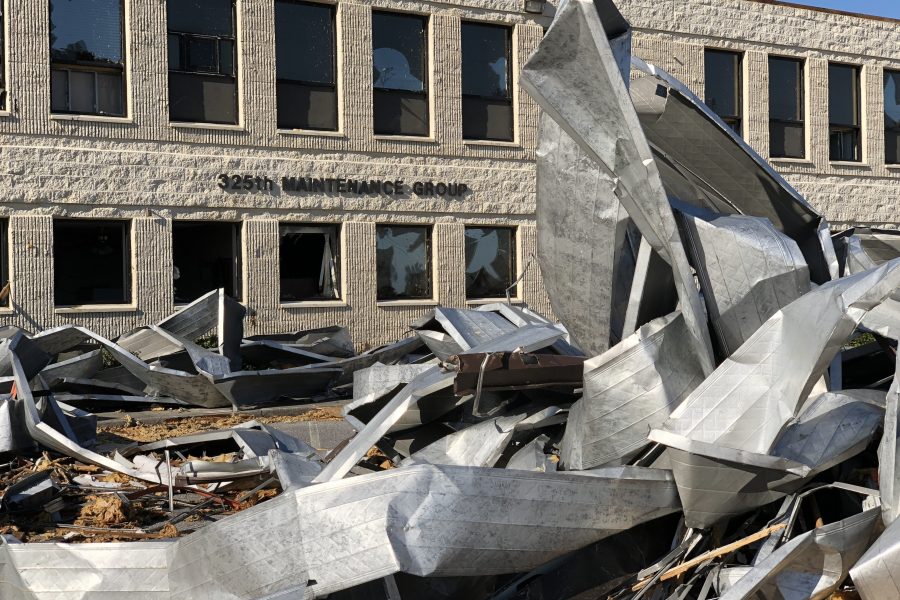The Air Force’s top installations official warned this week that defense budget constraints make it imperative that the service take a smarter approach to rebuilding facilities struck by natural disasters.
Targeted investments and storm preparation procedures can help avoid continued, costly recovery efforts after hurricanes and floods like those that recently hit Tyndall Air Force Base, Fla.; Offutt Air Force Base, Neb.; and JB Langley-Eustis, Va. Restoring Tyndall, a fighter jet hub, and Offutt, home to U.S. Strategic Command and several types of reconnaissance and emergency communications planes, could cost nearly $6 billion in total as the recovery price tag continues to rise.
“The doctrine in which we combat severe weather and combat severe weather threats is really no different than how we would combat a conventional adversary. We have to understand the adversary through intelligence, indications and warnings,” John W. Henderson, assistant Air Force secretary for installations, environment, and energy said July 28 during the online AFWERX Fusion conference. “Based on what we see and know, we have to maneuver against it, and in this case, defend against it.”
His remarks at the annual innovation-focused gathering come as the U.S. nears the heart of hurricane season. The National Oceanic and Atmospheric Administration predicts the 2020 Atlantic hurricane season could include as many as 19 named storms and 10 hurricanes through Nov. 30, six of which could become majorly damaging weather events.
While the East Coast is slated to see a busier-than-usual hurricane season, Hawaii and other areas of the Central Pacific should see two to six tropical depressions, named storms, and hurricanes this year—about average or fewer than normal, according to NOAA.
The Air Force last year issued 100 recommendations for how to handle natural disasters following Hurricane Michael, the Category 5 storm that hit Tyndall in October 2018. The service found its weather enterprise is in good shape, but should forge closer partnerships with other federal agencies.
“Recommendations here generally centered around improving our formal relationships with NOAA and the National Weather Service, and continuing the use of probability forecasts to support our operational commanders around the globe,” Henderson said. “This information helps commanders decide which threats require the most attention, and guides follow-on actions based on predicted impacts to their mission.”
Officials also suggested holding annual training exercises to practice emergency management protocols and evacuation and sheltering plans.
“These plans must be logistics-informed, with contingency stocks either on hand or with assured supply chains intact,” Henderson said. “Critical personnel and equipment should be identified as part of the ride-out teams so that immediate security and response actions are functioning once the storm passes. Finally, processes to support military and civilian personnel who are required to evacuate must be well-defined and rehearsed at the base level.”
He called for hardened emergency operations centers where essential personnel can wait out a storm and begin their response as soon as possible. Computer files should be backed up in cloud storage, and bases must have power, communications, and life-support equipment at the ready. Family housing should be prepared in similar ways as well, he said.
In a nod to the Air Force’s plan to tackle a $33 billion facilities maintenance backlog, Henderson said the service needs to more routinely assess the health of its installations and whether facilities are threatening the safety of combat equipment or people. Rebuilding facilities with water- and mold-resistant materials can help protect them during a storm, as well as avoid related illnesses and structural weakness that later stem from rain and flooding.
“We should not in any case be putting Airmen, weapon systems, and critical equipment into buildings that do not have the structural integrity to protect it,” Henderson said. “We need to update and revalidate our risk assessments as these missions and weapon systems change, because sometimes even a low probability presents an unacceptable risk.”
Editor’s note: This article has corrected the location of Offutt Air Force Base, Neb.

